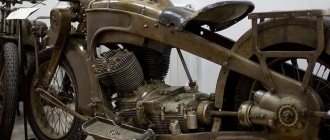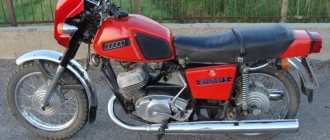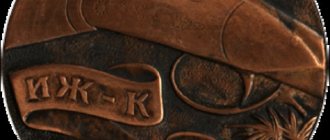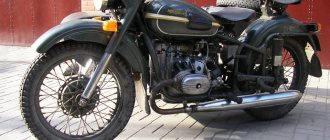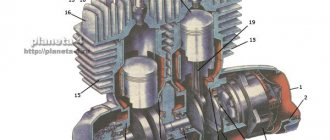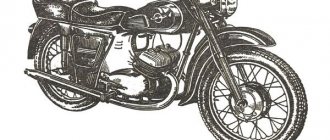home
In 1961, an Izhevsk motorcycle called Jupiter was released. A new family of IZH Jupiter has appeared. The design is similar to the IZH-56 motorcycle produced earlier. Its significant difference is the installation of a two-cylinder engine. In addition, some changes have been made to the clutch, gear shift device and electrical equipment.
Motorcycle IZH Jupiter technical characteristics
Total information
Motorcycle type - single Base, mm - 1360 Ground clearance, mm - 135 Dimensions, mm: Length - 2115 Width - 780 Height - 1025 Saddle height - 780 Motorcycle dry weight, kg - 160 Maximum speed, km/h - 110 Fuel tank capacity , l — 15 Fuel consumption rate on the highway, l/100 km — 4 Fuel range, km — 375 Filling oil capacity, l: gearbox housing — 1 of each front fork leg — 0.15 rear suspension elements (two) — 0 .12 air purifiers - 0.2
Motorcycle IZH-Jupiter technical characteristics engine
Engine type - two-stroke with two-channel return purge Number and arrangement of cylinders - two, vertical in-line Cylinder diameter, mm - 61.75 Piston stroke, mm - 58 Displacement, cm cubed - 347 Compression ratio - 6.7 - 7.0 Maximum power, l. With. — 18 Number of revolutions at maximum power, rpm — 4700-5100 Tax power, n. pp. - 1.33 Cylinder head: material - aluminum alloy combustion chamber shape - hemispherical Gasket material - rayasbestos Piston: material - aluminum alloy shape - convex Number of piston rings - 3 Piston pin (type) - floating Piston pin diameter, mm - 14 Protection against axial displacement - with stoppers. Valve timing, in degrees of crankshaft rotation: beginning of intake to c. m.t. - 75° end of intake after c. m.t. - 75° start of release to c. m.t. - 80° end of release after n. m.t. - 80° start of blowing after n. m.t. - 58° end of blowing after n. m.t. - 58° Engine lubrication - oil with gasoline Carburetor - K-28Zh Air cleaner - contact-oil Fuel filter - mesh in the sump
Power transmission
Clutch - multi-plate in an oil bath Gearbox: type - four-speed control - foot gear ratios: in first gear - 3.17 in second gear - 1.71 in third gear - 1.26 in fourth gear - 1 Total gear ratio (from the engine to the rear wheel): in first gear - 18.98 in second gear - 10.24 in third gear - 7.54 in fourth gear - 5.89 Forward gear: type - roller chain gear ratio - 2.57 Rear gear: type — roller chain gear ratio — 2.63 Chassis Frame — tubular, non-separable welded Front fork — telescopic with hydraulic shock absorbers Rear suspension — lever spring with hydraulic shock absorbers Tires: type — straight-bezel size in inches — 3.25-19 Brakes — shoe brake drive — mechanical separate
Ignition, electrical equipment
Ignition system - battery Battery battery: brand - 3-MT-7 capacity, a-h - 7 voltage, V - 6 Generator: brand - G36M2 voltage, V - 6 power, W - 45 Drive - the generator is mounted on the right axle of the crankshaft engine Regulator relay - two-stage Ground connection terminal - minus Signal - S-37 Headlight - FG-38
Engine IZH Jupiter
In 1961, an Izhevsk motorcycle called Jupiter was released. A new family of IZH Jupiter has appeared. The design is similar to the IZH-56 motorcycle produced earlier. Its significant difference is the installation of a two-cylinder engine. In addition, some changes have been made to the clutch, gear shift device and electrical equipment. At the front of the crankcase there are two crank chambers, and at the rear there is a gearbox. The crank chambers are closed with covers and each of them contains crankshafts on ball bearings, which are protected from axial displacement by retaining rings. The crankshaft axle shafts are sealed with oil seals. Under the left crankcase cover mounted on a gasket, the front chain drive, clutch and trigger mechanism are located. The crankshafts are connected to each other by an external flywheel. The generator rotor and the breaker cam are installed on the axle cone of the right crankshaft. The generator housing is mounted on the crankcase. The engine pistons are connected to the crankshaft connecting rods using piston pins, which are protected from axial displacement by retaining rings. The engine cylinders have aluminum jackets and cast iron liners. The cylinder heads are made of aluminum alloy and are attached together with the cylinders to the crankcase with studs.
Motor part
The motor part of the engine consists of a cylinder-piston group, a crank mechanism and a crankcase group.
Motor part of IZH Jupiter: 1 – generator cover; 2 – right crankcase cover; 3 – generator; 4 – right seal with cover; 5 – right crankshaft; 6 – right half of the crankcase; 7 – flywheel; 8 – crankshaft seal; 9 – crank chamber cover; 10 – left crankshaft; 11 – left seal; 12 – left half of the crankcase; 13 – crankshaft sprocket; 14 – left crankcase cover; 15 – cylinder; 16 – cylinder head; 17 – piston; 18 – spark plug; 19 – connecting rod; 20 – hairpin.
Engine parts IZH Jupiter
Engine parts: 1 – cylinder pipe; 2 – cylinder gasket; 3 – left cylinder; 4 – hairpin; 5 – left cylinder head; 6, 12 – washers; 7 – nuts; 8 – retaining ring; 9 – piston; 10 – piston ring; 11 – left cheek of the crankshaft; 13 – connecting rod; 14 – right cheek of the crankshaft; 15 – flywheel; 16 – bushing; 17 – piston pin; 18 – crankshaft; 33 – flywheel mounting bolt; 34 – crank pin; 35 – needle bearing.
Clutch
Located on the left side of the engine in an oil bath. Closed with a lid with a gasket to prevent oil leakage. The main thing that can be said when assembling the coupling. Some conditions need to be met. The first compression spring nuts should protrude 3.5 - 4.0 mm above the caps. This will save the disks from distortion. Tighten the second adjusting screw until it stops. Then loosen 1/4…1/2 turn. Essentially this is a clutch adjustment.
Details of the Izh Jupiter clutch: 19 – bracket with lever; 20 – outer clutch drum; 21 – pusher; 22 – ball; 23 – thrust rod; 24 – inner clutch drum; 25 – clutch drive disk; 26 – driven disk; 27 – pressure disk; 28 — cap; 29 – spring; 30 – shaped nut; 31 – adjusting screw; 32 – nut.
IZ Jupiter clutch diagram
The clutch of the IZH-Jupiter motorcycle differs from the clutch of the IZH-56 motorcycle by the installation of a ball bearing and an adjusting screw 31 with a lock nut 32.
Trigger
The starting mechanism is designed to start the engine. Has no adjustments. The parts are simply assembled in the right position and that’s it. During operation, worn parts are replaced with new ones. The gears and sector are the first to fail - inspect the teeth.
Starting mechanism of the IZH Jupiter motorcycle: 1 - washer; 2 — trigger pedal; 3 - roller; 4 — pedal axis; 5 - ball; 6 — clamp spring; 7 - clamp; 8 - bolt; 9 — reflector; 10 - cuff; 11 — kickstarter shaft; 12 - sector; 13 - spring; 14 — washer; 15 - ring; 16 — washer; 17 — spring; 18 - gear.
Gear shift mechanism
It is located inside the gearbox and the control lever is on the left side of the engine. It has changed the drive device of the shift sector and forks, which operate directly on the worm shaft. If the switch does not work properly. Disassemble the engine and wash all switching parts and check for wear and chips. Replace faulty ones.
IZ Jupiter gear shift mechanism: 4 – shift pedal; 25 – spring of the gear shift mechanism; 26 – gear shift sector; 27 – mechanism leash; 28 – shaft; 32 – worm shaft; 33 – fork for switching second and fourth gears; 34 – fork for shifting first and third gears; 36 – clamp spring; 37 – neutral contact post; 38 – neutral contact flag; 39 – switching anchor.
Transmission
The gearbox of the IZH-Jupiter motorcycle on the IZH-Yu motorcycle is the same as on the IZH-56 motorcycle and differs only in the design of the switching mechanism. Basic care is checking the oil and replacing it in a timely manner.
IZ Jupiter gearbox diagram: 1 – input shaft; 2 – secondary shaft; 3 – intermediate shaft; 4 – support ball bearings of the shafts; 5 – roller bearing of the secondary shaft; 6 – gearbox gears; 7 – secondary shaft oil seal; 8 – asterisk.
Engine diagram
Diagram of the engine block with gearbox, clutch and generator: 1 – spark plug; 2 – cylinder head; 3 – cylinder; 5 – piston; 6 – piston ring; 7 – bypass channel; 8 – piston pin; 9 – bushing of the upper head of the connecting rod; 10 – connecting rod; 11 – left crank chamber cover; 12 – drive sprocket; 13 – ball bearing; 14 – oil seal; 15 – left crankshaft axle shaft; 16 – roller bearing of the lower head of the connecting rod; 17 – crank pin; 18 – clutch spring; 19 – hatch cover; 20 – clutch adjusting screw; 21 – clutch pressure plate; 22 – inner drum; 23 – gear shift pedal; 24 – trigger pedal; 25 – left crankcase cover; 26 – clutch discs; 27 – outer clutch drum; 28 – trigger mechanism sector; 29 – spring; 30 – trigger gear; 31 – ball bearing; 32 – left half of the crankcase; 33 – gear shift fork; 34 – gear shift roller; 35 – gear shift sector; 36 – gear shift mechanism roller; 37 – fastening pin; 38 – right half of the crankcase; 39 – right cylinder head; 40 – right cylinder; 41 – flywheel; 42 – right crank chamber cover; 43 – cylinder gasket; 44 – right oil seal; 45 – generator; 46 – right crankshaft axis; 47 – right crankcase cover; 48 – generator cover; 59 – breaker cam; 50 – central anchor mounting bolt; 51 – asterisk; 52 – oil seal; 53 – roller bearing; 54 – secondary shaft; 55 – oil seal; 56 – input shaft; 57 – clutch release rod; 58 – clutch release lever; 59 – sprocket mounting nut; 60 and 61 – gearbox gears; 62 – clutch cable cam; 63 – clutch cam; 64 – spring.
This happens every year. But it is not exactly
This summer, the sky is decorated with two bright planets - Jupiter and Saturn.
They will decorate it in the fall - already slowly dispersing. But last year they were inseparable - there was even a moment when, to the eye, Jupiter and Saturn merged into one luminary. Jupiter, as it should be, then took the lead - it is the fastest planet... among the slow ones... or rather, among the giant planets. The largest and brightest. A lagging behind, many amateurs (who are not very good at navigating among the stars) have already lost sight of the constellation Saturn. But there are several other reasons for this - the bright nights of June and July, the high level of light pollution in cities, the low altitude above the horizon of both planets, although Jupiter is still slightly higher.
On August 20, 2021, Jupiter enters into opposition with the Sun, and this will be the best time to observe it. But the nights closest to the confrontation are practically no worse.
Let me remind you what confrontation is
Jupiter is an outer planet.
Its orbit is significantly larger in diameter than the Earth's orbit. This planet is more than 5 times farther from the Sun than Earth. And the distance from Earth to Jupiter changes every year. It can be closer or further. Of course, people think that it is easier to observe a planet when it is closer. In relation to Jupiter, this is true. But this is not always the case. For example, for the inner planets (Mercury and Venus), the observation position closest to the earth is inconvenient, since the planet is in the direction of the Sun.
But with regard to Jupiter, everything is exactly the opposite, and when it is closest to the Earth, it occupies a position in the sky opposite to the Sun - it opposes it. Hence the name of this planetary configuration - “Confrontation”.
One correct drawing is more than enough to understand the situation without unnecessary verbosity.
In the picture you can see that during the opposition the earth and Jupiter are located in a straight line on one side of the Sun. And, indeed, the distance between the planets is the shortest.
But opposition is different. We know that there are great oppositions of Mars. What about this for Jupiter? Are all his confrontations the same?
Talk about the great oppositions of Jupiter began relatively recently. Probably there is less and less great in our lives, and we pull it from heaven. and About 12 years ago, someone noticed that in some years Jupiter at opposition flares up to -2.5 magnitude (remember, stars are of first magnitude, and those that are zero are even brighter... and the brightest ones have a negative magnitude luminary). But there are special oppositions when Jupiter reaches almost -3rd magnitude, and its apparent diameter reaches almost one arcminute.
By analogy with the Great Oppositions of Mars, the special oppositions of Jupiter also began to be called Great.
In reality, the difference in distance to Jupiter as a percentage does not change as much from opposition to opposition as it does with Mars. Let me remind you that for the red planet the distance in opposition lies in the range from 55 to 102 million kilometers - the difference is almost 2 times. For Jupiter, a similar scatter in meaning ranges from 590 to 665 - this is a little more than 10%. Accordingly, the visual characteristics of the greatest of the planets change from opposition to opposition.
Gloss: -2.45m to -2.95m
Equatorial diameter: 44” to 50” (arcseconds).
But planets are still quite distant objects, and when observing them, every arc second plus their apparent size is worth its weight in gold. Therefore, of course, during the Great Opposition of Jupiter, more attention is focused on the planet than at all other times, unless something out of the ordinary happens... but it does happen.
To the first degree of approximation, oppositions of Jupiter occur every year. But each next one is a month later. If this year the confrontation is in August, then next year it will be in September. And it may happen (and does happen) that some year remains without confrontation - 2013 and 2025, for example.
Jupiter's great oppositions occur once every 12 years. But also - with some displacement.
This year's confrontation is not Great. but next year there will be a Great Confrontation. But here it is important to understand that the confrontations that precede the great and those that follow it essentially differ little from the great.
Here, compare.
The maximum brightness and apparent equatorial diameter that Jupiter will reach on August 20 will be: -2.9m and 49” respectively - almost the same as in a year. And the only thing that will make the next opposition significantly more convenient is the height of Jupiter above the horizon at our latitudes. This year it is a bit low.
But still, in August-September of this year, Jupiter is very bright and large in appearance. It would be a sin not to take advantage of this.
What can you see with budget optics on Jupiter and its vicinity?
First of all, these are the four largest satellites of the planet. They are already visible through 6x binoculars, although it is better to choose a stronger instrument, because even Galileo Galilei made this discovery through a telescope with 34x magnification.
It is noteworthy that the visual position of the Galilean satellites is constantly changing. Sometimes this becomes noticeable literally after a few minutes of observation, when a satellite appears from behind Jupiter, hides behind it, or two satellites seem so close that they even merge into one object, but after a few minutes they scatter and are visible separately quite clearly.
Several classes of phenomena occur regularly in the Jupiter satellite system. Here is a list of the main ones:
- passage of a satellite across the disk of Jupiter (entry and departure)
- passage of the satellite's shadow across the disk of Jupiter (entry and departure)
- occultation of a satellite by Jupiter/appearance of a satellite from behind Jupiter
- eclipse of a satellite by the shadow of Jupiter (beginning and end)
In addition, within each sequence there are intermediate phases of phenomena, because (for example) the entry of a satellite’s shadow onto the visible disk of a planet is an extended process.
There are eclipses and occultations of satellites with each other, as well as so-called “disappearances of satellites,” when in a small telescope near Jupiter nothing resembling satellites is visible at all, as if they do not exist at all.
Galileo also proposed determining the exact time by the phenomena in the system of Jupiter and its satellites.
Why is this needed, you ask? Aren't just stars enough for this?
Indeed, already many centuries before Galileo, the technology for determining time by the Sun and stars existed. However, both were suitable if the observer knew his position exactly.
And if the ship was caught in a storm, the ship's chronometer got wet and stopped... How to determine the coordinates of the ship? You need to know the exact time. And here the satellites of Jupiter will help (and have helped more than once) - looking at their round dance through the sea tube, it is not difficult to notice one of the phenomena in the system (every day one or more happens), and according to them again set the ship's chronometer at the right time. And at noon, from the difference between the moments of the upper culmination of the Sun and the chronometer readings, the captain quite accurately knows the longitude. And to determine latitude, you only need the height of the polar star or the point in the constellation Octantus, which the Southern Cross points to.
True, very soon a problem arose in this method of determining sea coordinates. While Jupiter is close to opposition, tables with pre-calculated moments of phenomena in the system of Jupiter’s satellites coincided well with reality. But when Jupiter was close to conjunction with the Sun, the error could be 15 minutes. And this already gave a significant error in determining the coordinates. And in general, how is this permissible in the science of astronomy, where everything should be very accurate!
The problem was solved in 1676 by Olaf Roemer, a Danish astronomer who worked at the Paris Observatory. Roemer suggested that since the phenomena are detected later when Jupiter is further from the Earth, then this additional distance introduces a delay - it takes more time for light to convey information about an event in the system of Jupiter when it is located behind the Sun, compared to when Jupiter is in opposition.
This was a very insightful explanation. Olaf Römer was the first person to measure the speed of light. Before this, it was believed that light was so fast that it spread - if not instantly through the entire universe, then - so quickly that a person would never be able to measure its speed.
There is one less “Never” left.
But Jupiter hasn’t added more satellites for a very long time.
The fifth satellite - Amalthea - was discovered only in 1892 - almost three centuries after Galileo. It turned out to be very small - a couple of hundred kilometers in diameter, and not at all spherical in shape. And now it is absolutely clear that Jupiter no longer has anything comparable to the Galilean satellites - this despite the fact that the number of known satellites of the gas giant tends to a hundred. All his other retinue are small, irregularly shaped rocks - captured asteroids or fragments of something that once collided and scattered in his vicinity, or perhaps was torn apart by tidal disturbances. It’s not for nothing that Jupiter has rings...
We will not see the rings of Jupiter in any telescope.
However, it is worth mentioning that long before the flight of Voyager 1, the existence of Jupiter’s rings was predicted by the Soviet astronomer Sergei Konstantinovich Vsekhsvyatsky. No one can now say for sure what was most important in Vsekhsvyatsky’s predictions - the special gift of an observer, the insight of a theorist capable of subconsciously analyzing the data accumulated by science, or a special sixth sense that allowed him to make sensational assumptions without having either observational or theoretical support. But Vsekhsvyatsky’s predictions very often came true.
Jupiter's rings, alas, turned out to be very weak. Even the two very first probes - Pioneer 10 and Pioneer 11, which visited the vicinity of this planet, did not find any rings, and Voyager 1 was able to photograph them exclusively in backlight, when Jupiter eclipsed the Sun.
But Jupiter has something else that accompanies it and obeys it as unquestioningly as satellites and rings - these are at least three families of asteroids - very numerous: Greeks, Trojans and Hilds.
Each of the families contains thousands of objects.
With the Greeks and Trojans everything is more or less simple. In fact, these are two clouds of several thousand small planets each, located at the Lagrange points L4 and L5 of the Sun-Jupiter system. That is, the Greek family moves in the orbit of Jupiter 60 degrees ahead of it, and the Trojans are lagging behind by the same amount. When these objects first began to be discovered, they were given the names of Greek or Trojan heroes from Homer’s poem “The Iliad.” But apparently, the list of military personnel of ancient Hellas ended long ago, and these asteroids are being discovered and discovered.
By the way, similar celestial bodies were discovered in the orbits of the Earth, Mars, Saturn, Uranus and Neptune - with the same functional dependence. Venus did not get a full-fledged Trojan asteroid - it seems to have one, but periodically runs away from it. And for Mercury, nothing like this has yet been discovered.
With Hilda’s family it’s a little more complicated. They are not rigidly tied to any reference points, but jump from point L3 to L5, and then to L4, and again to L3 - slowing down near these points, and significantly accelerating during the migratory stages.
The reason for this, of course, is the strong gravity of Jupiter, which does not allow these asteroids to live their own independent lives.
Jupiter rules over the largest family of comets. This family includes 172 short-period comets, the aphelion of their orbits is limited by the orbit of Jupiter, or the orbital period does not exceed 20 years. All of them in the past had a close approach to the largest planet of the Solar system, which affected the evolution of the cometary orbit, and did not allow them to return back to the Oort cloud, from where new comets fly to us - into the circumsolar space - blocks of water ice with pebbles frozen in the ice and dust.
Jupiter has swallowed up at least three comets in recent years. Surely, throughout its history, the number of celestial bodies that have sunk into its depths is in the millions.
What else surprised astronomers about Jupiter during their very first telescope observations?
Jupiter exhibits the greatest oblateness at the poles in the solar system. This is a consequence of the planet's rapid rotation. A Jovian day lasts less than 10 hours. There is no other planet in the solar system that manages to turn around its axis faster than 10 hours. But here it is worth noting that Jupiter is not all that fast, but only its equatorial zone, where a day lasts 9 hours 50 minutes. Mid-latitudes complete their daily rotation in 9 hours and 55 minutes. But the polar regions do not have time to meet it in 10 hours.
When speaking about the daily rotation of the planet, astronomers mean the upper layer of the atmosphere visible through a telescope. Essentially we are talking about the rotation of the cloud layer. What is happening there in the depths, and maybe there are completely different days there - this is not known for certain. By the way, the top layer of clouds of Venus makes a revolution around the planet in just 4 Earth days, and the solid part of Venus rotates around its axis very slowly - one revolution in 243 Earth days.
With Jupiter there cannot be such a large spread between more or less deep layers of the atmosphere in rotation speed. This is precisely evidenced by the polar compression - which is 6.5%. And this says that virtually the entire mass of the planet rotates around its axis quite quickly.
Well, astronomers determine the period of rotation around Jupiter’s axis by characteristic and stable formations in the atmosphere.
The first such formation was discovered back in the era of Galileo and is the largest atmospheric cyclone in the solar system, which has not stopped for 4 centuries. However, its size has been halved over the past 100 years (although it is now several times larger than the Earth). And who knows, maybe we are the last generation of people who could see the Great Red Spot. This vortex drifts across the southern hemisphere of the planet, absorbing other tornadoes and tornadoes, and is one of the key points for measuring planetary longitude on Jupiter. How planetary scientists will determine the physical coordinates of Jovian objects after the disappearance of the Great Red Spot is not very clear. After all, all other atmospheric formations on Jupiter are even less stable and already very short-lived.
Even with the smallest telescope, cloud bands are visible on Jupiter - the southern and northern equatorial belts. In a larger telescope, two more thin belts are added to them, and in a sufficiently powerful instrument one can count many such atmospheric belts.
Not long ago, the Southern Equatorial Belt, which was consistently observed by Huygens and Cassini, suddenly disappeared. Moreover, the loss was discovered by amateur astronomer Anthony Wesley, whose message provoked an urgent turn of the Hubble Telescope towards the gas giant. And Jupiter was again carefully examined by the most vigilant orbital eye of earthlings.
The processes that occur in the atmosphere of Jupiter can be compared to “boiling”... okay - to “cryo-boiling”, because the temperatures on Jupiter - in its visible part - are quite low. But his life is literally in full swing, as can be seen in photographs taken from unmanned research stations.
What does it all consist of?
The main chemical element on Jupiter is hydrogen.
It's up to 90% here. The rest is helium and other representatives of Mendeleev’s periodic table, of which there is significantly less than 1%. The upper layer of the atmosphere is very cool - about -150 degrees. But as you dive deeper into its cloudy depths, the temperature rises. And in the center of the planet, where, according to some assumptions, there may even be a rocky core, the planet is as hot as the surface of the Sun. But even in the upper atmosphere, Jupiter is noticeably warmer than might be expected. For the first time, such a discrepancy was discovered by the Pioneers - Jupiter emits into space 2 times more energy than it receives from the Sun. And for some time, the trend was the hypothesis that Jupiter could burst into flames as a star if thermonuclear reactions started in its core.
Of course, Jupiter cannot be a star. According to modern criteria, in order to sustain thermonuclear reactions sustainably, it needs to have a mass 20 times greater than what it has now. Of course, due to the comets and asteroids falling on him, he will never gain so much, and he has nowhere else to get this, even if he manages to absorb all the planets of the solar system.
But it is worth noting the position of Jupiter in terms of mass ratio: it is 300 times more massive than the Earth, and 1000 times “lighter” than the Sun, while it is 2.5 times more massive than all other planets in the solar system.
And in diameter it is exactly in the middle between the Earth and the Sun - 10 times larger than one, and 10 times smaller than the other. It's beautiful here.
In recent years, some satellites of Jupiter have been suspected of having life on them. First of all, these are Io and Europa - one has thermal zones near continuously active volcanoes, and the other has a deep ocean under a thick shell of ice. But in the atmosphere of Jupiter itself, the possibility of special forms of life is also being considered, and therefore projects are being developed for research airships floating among the Jovian clouds - suddenly cryolife flourishes in these cryo-worlds.
Of course, more realistic expeditions to satellites are also being prepared, involving landing and direct study of samples. I think we will see the implementation of these bold projects.
Well, right now the space station Juno (Juno) is circling in the Jupiter system. It was expected that in 2021 it will complete its mission. But the device is in good working order and can last for several more years. In any case, its work has been extended until 2025, and maybe further there.
During the dark nights of August 2021, Jupiter shines on the border of the constellations Aquarius and Capricorn. He is moving backwards (an astrologer would say retrograde). During oppositions, all planets move backwards, describing loops.
The next two nights after opposition (August 21/22 and August 22/23), the full Moon will be near Jupiter. She will continue to visit him - about once a month.
Until mid-October, Jupiter maintains its retrograde motion and slowly approaches Saturn, which will be nearby all this time - in the same constellation Capricorn. But then Jupiter will resume direct movement, rushing towards the constellation Aquarius, which it will only be able to enter in mid-December.
Electrical equipment of the IZH Jupiter motorcycle
The electrical equipment of the IZH Jupiter motorcycle differs only in the installation of the G-36M2 generator.
Electrical diagram of the IZH Jupiter motorcycle:
1 — rear light; 2 — neutral lamp switch; 3 - central switch; 4 — neutral indicator lamp; 5 — speedometer lighting lamps; 6 - main lamp; 7 — parking light lamp; 8 — light switch; 9 — sound signal; 10 — brake light switch; 11 - candle; 12 — control lamp; 13 - fuse; 14 - battery; 15 — relay-regulator; 16 - generator; 17 - capacitor; 18 - breaker; 19 - ignition coil.
Motorcycle IZH Jupiter K with an increased gear ratio in reverse gear. The drive sprocket is installed with a smaller diameter and fewer teeth. The presence of a stroller forced the manufacturer to increase the torque, but reduce the speed to 80 km/h.
New photos of Jupiter
Three images of Jupiter from the Gemini North 8-meter telescope at Gemini Observatory and the NASA/ESA Hubble Space Telescope show the gas giant in three different types of light (infrared, visible and ultraviolet). The image shows many atmospheric features, such as the Great Red Spot, super storms and cyclones stretching across the planet's disk.
New images of Jupiter highlight a key advantage of multi-wavelength astronomy : viewing planets and other astronomical objects at different wavelengths of light allows scientists to gain insights otherwise unavailable.
The distance between our planet and the largest planet in the solar system varies from 588 to 967 million kilometers. Once every 12 years, Jupiter is near the perihelion of its orbit - this period astronomers call the great opposition.
Note that visible and ultraviolet views of the planet were captured using Wide Field Camera 3 on the Hubble Space Telescope. The infrared image was obtained using a near-infrared thermal imaging instrument at Gemini North in Hawaii. All three sightings were made at the same time, 11 January 2021 at 15:41 GMT.
Jupiter in infrared light. Near the summit, a long brown feature called the "brown barge" extends 72,000 km in an east-west direction. The Great Red Spot prominently appears in the lower left corner, while a smaller object nicknamed Red Spot Jr. appears in the lower right corner.
